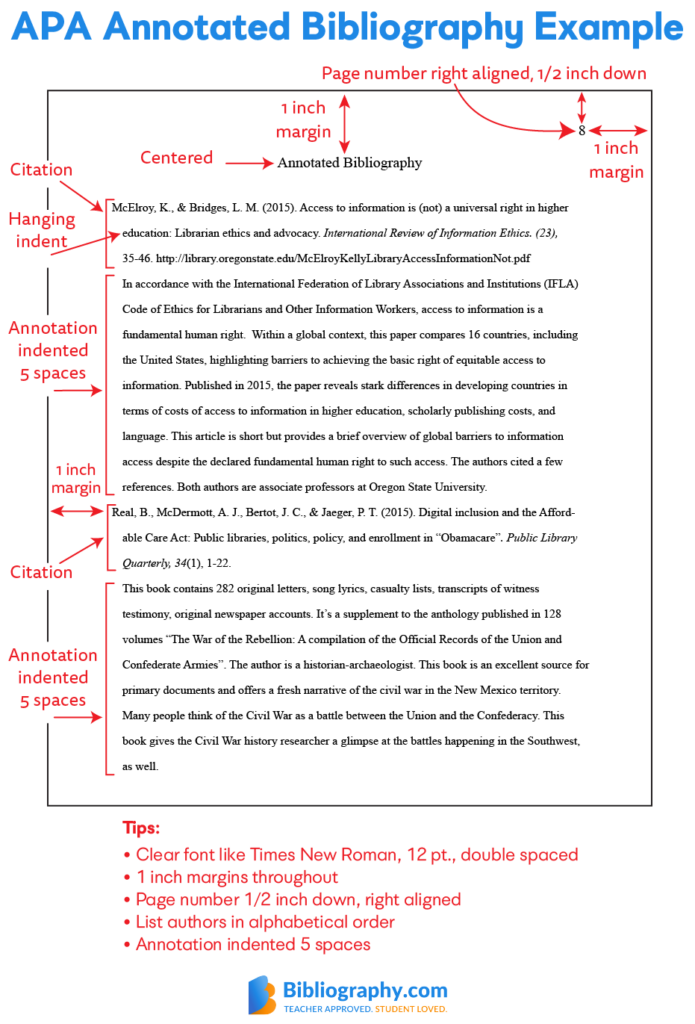
Annotated Bibliographies:
Citing sources and creating a comprehensive bibliography serve the purpose of supporting your argument and claims through demonstrable research. By including citations in your bibliography, readers can cross-reference and independently access the referenced materials. However, while a bibliography provides a compilation of the research sources along with publication details, it does not provide an insight into the inherent quality and content of these sources.
An annotated bibliography is a valuable tool used in academic writing that provides an overview of the sources available on a given topic. Unlike a traditional bibliography, which lists sources without any additional information, an annotated bibliography includes brief annotations or descriptions of each source.
What is an annotated bibliography- Definition and Meaning:
In the context of an annotated bibliography, an annotation is a brief summary (around 150 words) accompanying each citation that provides a concise description of the source’s key content, arguments, and findings. Annotated bibliographies assist readers in understanding the significance of each source and determining its suitability for their research needs thereby allowing them to make informed decisions about which sources to explore further in their research.
There are several online tools termed as “Annotated bibliography generators” that help in creating annotated bibliographies efficiently. Some of the commonly used ones include EndNote, EasyBib, Citation Machine, and Bibliography.
The following is a typical example of an annotated bibliography:
Smith, John A. (2020). “Nanoparticles as Drug Delivery Systems: Current Trends and Future Prospects.” Nanomedicine Journal, 45(2), 123-145.
Smith’s paper provides an overview of the current state of nanoparticle-based drug delivery systems. It discusses the advantages of nanoparticles in terms of targeted drug delivery, reduced side effects, and improved therapeutic outcomes. This source is valuable for understanding the potential applications of nanotechnology in medicine.
What is the Purpose of an annotated bibliography
The main purpose of an annotated bibliography is to:
- Systematically log and evaluate sources relevant to a particular research topic.
- Serve as a concise repository of citations, each accompanied by a brief, critical annotations that summarize the source’s content.
- Help to assess the source’s quality and credibility.
- Assist in organizing research, preventing unintentional plagiarism, and identifying research gaps.
How to write an annotated bibliography:
Writing an annotated bibliography requires a rational assessment of the topic, concise presentation, and a thorough library research. The format of an annotated bibliography depends on the citation style followed in the article. Each entry in an annotated bibliography typically includes:
- Proper citation as per the designated style (MLA, APA, CMS, etc.).
- Explanation of the main concept and/or objectives of the work.
- Assessment of the author’s authority or qualifications.
- Identification of the work’s strengths and limitations.
- Consideration of the perspective from which the work is written, including potential biases or target audience.
- Evaluation of the work’s relevance about both the subject matter under discussion and your research topic.
Types of annotations:
Different research contexts call for different annotation types and the choice of annotation depends on what information is most crucial for the readers to gather from a source. The 3 most common types of annotation are discussed below with examples:
Descriptive annotation:
A descriptive annotation or an informative annotation is a succinct summary of a source’s content that provides an objective overview of the work’s key focus, arguments, and findings. Unlike evaluative annotations, which include judgments or assessments of the source’s quality, a descriptive annotation focuses solely on presenting the source’s content without passing any judgments. It helps researchers get a quick understanding of a source’s relevance to their topic without delving into the source itself.
Descriptive annotation example:
Smith, J.A. and Garcia, M.C. (2020). Effects of Temperature Variation on Bacterial Growth Rates. Journal of Microbiology and Biotechnology, 4(1), 48-50.
Annotation:
This peer-reviewed research article, authored by John A. Smith and Maria C. Garcia, published in the Journal of Microbiology and Biotechnology in 2020, investigates the influence of temperature fluctuations on bacterial growth rates. The study employs a controlled laboratory setting and a variety of bacterial strains to assess how temperature variations within a specified range impact microbial growth. The article presents a detailed methodology, experimental results, and statistical analyses, providing readers with a comprehensive understanding of the research process and outcomes. This source is particularly valuable for researchers and students seeking insights into the relationship between temperature and microbial growth in controlled environments, contributing to the field of microbiology and biotechnology.
Evaluative annotation:
An evaluative annotation is a concise yet critical summary of a source that goes beyond mere description by assessing its quality, credibility, and relevance. It not only outlines the source’s main arguments but also evaluates their significance within the context of the research topic, thereby enabling researchers to make informed decisions about its inclusion in their own work.
Evaluative annotation example:
Johnson, M.K. and Smith, J.A. (2022). Efficacy of Drug X in Treating Advanced Stage Lung Cancer: A Randomized Controlled Trial.
Annotation:
This 2022 clinical research article, authored by Mary K. Johnson et. al., presents findings from a randomized controlled trial investigating the efficacy of Drug X in treating advanced-stage lung cancer. The study’s methodology is robust, with a well-designed trial structure, a sizable and diverse participant cohort, and clear inclusion/exclusion criteria. The results indicate a statistically significant increase in progression-free survival for patients receiving Drug X compared to the control group. However, it’s important to note that the article could benefit from a more comprehensive discussion of potential side effects and long-term outcomes. While the study’s findings are promising, further research and longer-term follow-up studies are warranted to establish Drug X as a standard treatment option in advanced lung cancer therapy. Despite this limitation, the article contributes valuable insights to the field of clinical oncology and informs future.
Reflective annotation:
A reflective annotation serves the purpose of assessing a source’s relevance, applicability, and impact on one’s research, focusing on how it contributes to the research objectives. Unlike descriptive annotations that merely summarize content or evaluative annotations that critically analyze a source, reflective annotations prompt researchers to contemplate how a source aligns with their research goals and methodologies.
Reflective annotation example:
Johnson, M.K. and Smith, J.A. (2021). Innovations in Diabetes Care: A Comprehensive Review. Clinical Research Review. 45(2), 50-55.
Annotation:
This 2021 clinical research review, authored by Mary K. Johnson and John A. Smith, offers a comprehensive examination of innovations in diabetes care. As I embark on my own clinical research project focused on improving diabetes management strategies, this source holds notable relevance. The review delves into emerging technologies, treatment modalities, and patient-centered approaches, all of which are critical aspects of my research agenda. Moreover, the source emphasizes the importance of patient outcomes and quality of life, which aligns perfectly with the patient-centered outcomes I aim to assess in my study. This source not only informs but also inspires my research direction, providing valuable insights and a methodological framework for my investigation into innovative diabetes care interventions.
Annotated Bibliography Examples:
An annotated bibliography template/sample typically looks like this:

Image Source: https://www.bibliography.com/apa/developing-an-apa-annotated-bibliography/
However, as mentioned before, the format depends on the citation style used. The examples of each style are given below:
MLA style annotated bibliography:
Smith, John A. “The Influence of Social Media on Adolescent Well-Being.” Journal of Adolescent Psychology, vol. 45, no. 3, 2019, pp. 267-284.
Annotation:
In this scholarly article, published in the Journal of Adolescent Psychology, Smith examines the impact of social media use on the mental health and overall well-being of adolescents. He presents findings from a longitudinal study conducted over three years, highlighting the correlation between excessive social media engagement and increased levels of stress and anxiety among teenagers. Smith’s research contributes valuable insights to the ongoing discourse surrounding the negative consequences of social media on the mental well-being of young individuals. This source is particularly relevant to my research on the effects of digital media on adolescent mental health and will serve as a foundational reference for my study.
APA style annotated bibliography:
Smith, J. A. (2018). The Influence of Social Media on Adolescent Well-Being. Journal of Adolescent Psychology, 45(3), 267-284. doi:10.1234/jap.2018.04503.
Annotation:
Smith’s scholarly article investigates the effects of social media use on the mental health of adolescents. In a comprehensive study spanning three years, Smith establishes a significant association between excessive social media engagement and elevated levels of stress and anxiety among teenagers. The longitudinal nature of the research and the use of standardized measurement tools enhance the credibility of the findings. This source is integral to the ongoing discourse on the detrimental impact of social media on adolescent well-being. It serves as a foundational reference for research into digital media’s influence on mental health among youth.
Chicago Manual style annotated bibliography:
Smith, John A. “The Influence of Social Media on Adolescent Well-Being.” Journal of Adolescent Psychology 45, no. 3 (2018): 267-284.
Annotation:
Smith’s research article explores the impact of social media on the mental well-being of adolescents. Over a span of three years, Smith conducted an extensive study that reveals a significant correlation between increased use of social media and heightened levels of stress and anxiety among teenagers. The author’s longitudinal approach and reliance on standardized assessment tools lend credibility to the research findings. This source is instrumental for understanding the ongoing discourse on the detrimental effects of social media on the mental health of adolescents. It serves as a foundational reference for future research into digital media’s influence on youth mental well-being in the field of adolescent psychology.









Leave a Reply